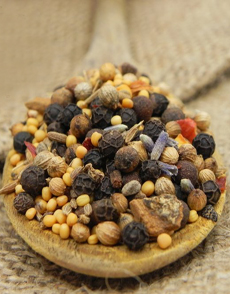TIP OF THE DAY: Spice Blends You Should Know, Part 2
|
Yesterday we presented the first five of the world’s 10 spice blends you should know: adobo from Mexico, chili powder from Mexico, five spice from China, garam masala from India and jerk from Jamaica. Even if you won’t be cooking with them anytime soon, you should know them: They’re popular global, popping up in fusion dishes outside their native cuisines. The second half of the Top 10 include nori shake from Japan, pimentón from Spain, quatre épices from France, ras el hanout from Morocco and za’atar from the Middle East. Nori shake is made from sheets of nori seaweed (the type used to wrap sushi rolls), ground with with salt and sesame seeds. Nori is the seaweed, furi means shake. Beyond its traditional use as a rice seasoning, shake it on other grains, cooked vegetables, plain yogurt and dips. |
Quatre epices, a bend of cloves, ginger, nutmeg and pepper. Photo courtesy Silk Road Spices | Canada. |
|
|
Pimentón is the Spanish word for what is better known as paprika, a spice ground from dried New World chiles (Capsicum annuum). Although paprika is often associated with Hungarian cuisine, in Europe it was first used in Spanish recipes. The story has it that Christopher Columbus brought the ground chiles back to Spain at the end of his second voyage. It was served to King Ferdinand and Queen Isabella, who found it too hot and spicy; but local monks shared it with other monasteries. It spread throughout Spain, and subsequently to Hungary and elsewhere. |
||
|
Ras el hanout can be a blend of 30 or more |
QUATRE ÉPICES Quatre épices (kahtr-ay-PEECE) is a French spice mix that is also used in some Middle Eastern cuisines. The name literally means “four spices,” and they are cloves, ginger, nutmeg and pepper. There is no one recipe for ras el hanout: Every Moroccan spice merchant has a proprietary recipe, and the cooks who buy the spices debate who has the best version. The name translates as “top of the shop” and the mixture often includes 30 or more of a spice merchant’s best ingredients: whole spices, dried roots and leaves, ground together. |
|
|
Some of the 30 can be exotics as cubeb berries, grains of paradise, and rose petals; or more the more familiar ingredients listed below. The complex blend delivers many subtle undercurrents of floral, peppery and sweet. Za’atar (also spelled zahtar) is a spice blend that is very popular in Middle Eastern cuisines, including Israeli. Za’atar is actually the word for Lebanese oregano, a member of the mint family Lamiaceaea, and known since antiquity as hyssop. The za’atar blend includes spices well-known in European cuisines, with the unique components of Lebanese oregano and sumac berries. The latter grow in the Mediterranean and parts of the Middle East. They impart a tart, fruity flavor that differentiates za’atar from other spice blends. |
||




